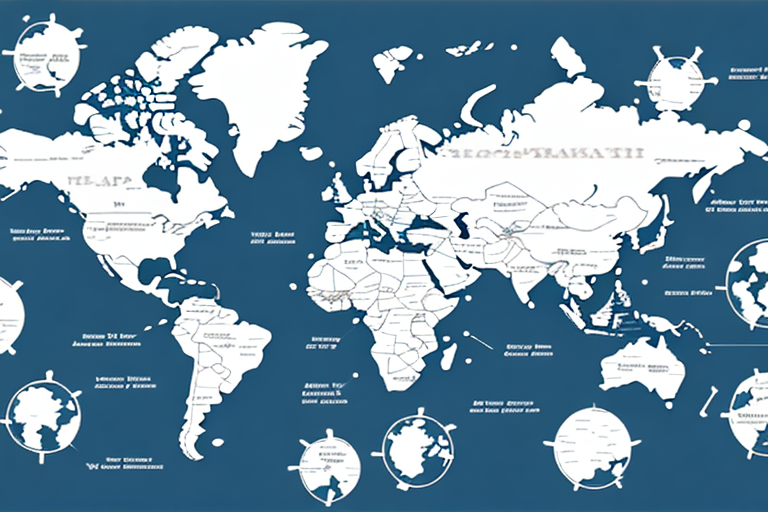Understanding UPS Shipping Rates and Zones
When it comes to shipping goods with UPS, having a clear understanding of shipping rates and zones is crucial. This article provides detailed information on UPS shipping rates and their calculation methods, the various factors affecting your shipping costs, and how to determine your shipping zone. Additionally, we explore strategies to save money on UPS shipping rates, tips for choosing the right service for your business needs, and much more. Let’s dive in!
What are UPS Shipping Rates and Zones?
UPS shipping rates are the charges customers pay to ship their packages with UPS. These rates are determined by several factors, including the destination of the package, its weight and dimensions, and the type of service selected by the customer. UPS shipping zones, on the other hand, refer to the geographic areas in which UPS operates, divided based on the distance between the point of origin and the destination. Generally, the closer the destination is to the origin, the lower the shipping rates tend to be.
UPS also offers various discounts and promotions. For instance, customers who frequently ship with UPS may qualify for discounted rates through their loyalty programs. Seasonal promotions or discounts for specific shipment types, such as holiday packages or international shipments, are also available. Always check for any applicable discounts or promotions before shipping with UPS to maximize your savings.
How are UPS Shipping Rates Calculated?
UPS shipping rates are calculated based on several factors:
- Package Weight and Dimensions: Heavier and larger packages typically incur higher shipping costs compared to smaller and lighter ones.
- Shipping Distance: The farther the distance between the origin and destination, the higher the shipping rates.
- Shipping Speed: Faster shipping options, such as overnight delivery, are more expensive than standard shipping.
- Additional Services: Services like insurance or signature confirmation add to the overall cost.
Furthermore, UPS offers discounts for customers who ship frequently or in large volumes, which can help reduce overall shipping costs. UPS provides various shipping options, including ground, air, and international shipping, each with its own set of rates and delivery times. Choosing the option that best fits your needs and budget is essential for cost-effective shipping.
Factors that Affect UPS Shipping Rates
Several factors can influence your UPS shipping rates:
- Package Weight and Dimensions: Accurate measurement and weighing of your package are crucial to avoid unexpected costs.
- Shipping Distance: Longer distances result in higher shipping rates.
- Shipping Speed: Faster delivery options come at a premium.
- Type of Service Selected: Different UPS services have varying rate structures.
- Destination Country: International shipments may have additional fees and requirements.
- Value of the Package: Higher-value items may require insurance, increasing the cost.
- Time of Year: Peak seasons like holidays can affect shipping rates and availability.
Special considerations include packages that are fragile or require special handling, which may incur additional fees. Shipping hazardous materials also requires special permits and packaging, further increasing costs.
How to Determine Your Shipping Zone
Determining your UPS shipping zone is essential for accurate cost calculation. Here are ways to determine your shipping zone:
- UPS Zone Locator Tool: Use the UPS Zone Locator tool on the UPS website. Enter your zip code and the recipient’s zip code to find the appropriate UPS shipping zone.
- UPS Rate and Service Guide: Consult the UPS Rate and Service Guide for detailed zone information.
Remember, UPS shipping zones are based on the distance between origin and destination zip codes. The greater the distance, the higher the shipping cost. Additionally, consider the weight and dimensions of your package, as these factors also impact the cost. Accurate determination of your shipping zone and package details ensures a precise shipping cost estimate and helps avoid unexpected fees or delivery delays.
The Different UPS Shipping Zones Explained
In the United States, there are nine different UPS shipping zones, numbered from 1 to 9. Zone 1 is the closest to the point of origin, while Zone 9 is the furthest. The cost of shipping to a particular zone depends on the package's weight and dimensions, selected shipping speed, and any additional services.
UPS regularly updates its shipping zones to optimize efficiency and reduce delivery times. Therefore, it's advisable to check the current UPS shipping zone map before sending a package to ensure you are using the correct zone and obtaining the best possible shipping rates.
Special zones exist for certain shipment types, such as hazardous materials or oversized packages. These special zones may have different shipping rates and delivery times compared to standard zones. Always verify with UPS or a shipping expert to ensure you are using the correct zone for your specific shipment.
How to Save Money on UPS Shipping Rates
Businesses can implement several strategies to save on UPS shipping rates:
- Negotiate Better Rates: Engage with UPS to negotiate discounts based on your shipping volume and frequency.
- Select Slower Shipping Speeds: Opting for standard or ground shipping instead of expedited options can significantly reduce costs.
- Use Lighter Packaging: Reducing the weight of your packages can lower shipping costs.
- Consolidate Shipments: Combining multiple shipments into a single package can be more cost-effective.
- Utilize UPS's Online Tools: Tools like the UPS Shipping Calculator help compare rates for different shipping options to choose the most cost-effective one.
- Leverage UPS WorldShip and CampusShip: These online shipping tools offer discounts and streamline the shipping process.
- Compare Alternative Shipping Carriers: Evaluate rates from other carriers like FedEx or USPS to ensure you are getting the best deal.
Regularly reviewing your shipping costs and adjusting your strategies accordingly ensures that you are maximizing savings and getting the best value for your shipping needs.
Tips for Negotiating UPS Shipping Rates
Negotiating better rates with UPS can lead to significant cost savings. Here are some tips to effectively negotiate:
- Know Your Shipping Volume: Understand your shipping patterns and volumes to present a strong case for discounts.
- Be Prepared: Have a clear plan and strategy when approaching UPS for rate negotiations.
- Highlight Loyalty: Emphasize your long-term relationship and consistent shipping volume with UPS.
- Compare Competitors: Use quotes from other carriers as leverage during negotiations.
- Be Ready to Switch: Demonstrating willingness to switch to another carrier can strengthen your negotiating position.
Ways to Reduce Your Shipping Costs with UPS
Beyond negotiating better rates, here are additional ways to lower your UPS shipping costs:
- Use Free Packaging: Take advantage of free packaging materials provided by UPS to reduce costs.
- Avoid Dimensional Weight Surcharges: Choose appropriate packaging to prevent high dimensional weight charges.
- Optimize Delivery Scheduling: Utilize the UPS My Choice program to schedule deliveries more efficiently and avoid costly expedited options.
Understanding the Impact of Dimensional Weight on Your Shipping Rates
Dimensional weight significantly impacts UPS shipping rates by considering the space a package occupies during transport, regardless of its actual weight. If a package has a high dimensional weight relative to its actual weight, the shipping cost increases. Understanding how dimensional weight is calculated and selecting the right packaging can help reduce your shipping costs.
To calculate dimensional weight, use the formula provided by UPS:
- Dimensional Weight (lbs) = (Length x Width x Height) / 139
Ensure your packaging minimizes unnecessary space to lower dimensional weight charges.
Comparing UPS Ground vs Air Shipping Rates
UPS offers both ground and air shipping options, each catering to different needs:
- UPS Ground: More economical and suitable for non-urgent shipments. Delivery times vary based on distance.
- UPS Air: Includes services like UPS 2nd Day Air and UPS Next Day Air, which are faster but more expensive than ground shipping.
The cost of each option depends on package weight, dimensions, shipping distance, and any additional services selected. Businesses must assess their urgency and budget to choose the most appropriate shipping method.
Pros and Cons of Using UPS for Your Shipping Needs
UPS is a popular choice for businesses due to its extensive network and reliable service. Here are some pros and cons to consider:
- Pros:
- Fast and reliable service
- Wide range of shipping options
- Excellent tracking and customer support
- Global shipping capabilities
- Cons:
- Higher shipping rates compared to some competitors
- Potential dimensional weight charges
- Complex rate structures can be confusing
Weighing these pros and cons helps businesses determine if UPS aligns with their shipping requirements and budget.
Common Mistakes to Avoid When Using UPS for Shipping
Avoid these common mistakes to optimize your UPS shipping experience:
- Incorrect Package Size or Weight: Always accurately measure and weigh your packages to prevent unexpected fees.
- Choosing the Wrong Shipping Speed: Select a shipping speed that matches your delivery needs to avoid unnecessary costs.
- Poor Labeling: Ensure all packages are properly labeled to prevent delivery delays or returns.
- Neglecting to Review Shipping Costs: Regularly assess your shipping expenses to identify areas for cost savings.
By avoiding these mistakes, businesses can reduce shipping costs and ensure timely and reliable deliveries.
Understanding the Different Types of UPS Services Available
UPS offers a diverse range of services tailored to various business needs:
- UPS Ground: Cost-effective option for non-urgent shipments within the continental United States.
- UPS 2nd Day Air: Guarantees delivery by the end of the second business day.
- UPS Next Day Air: Ensures next-day delivery by a specified time.
- UPS Worldwide Express: Fast international shipping with guaranteed delivery times.
- UPS Freight: Solutions for larger, heavier shipments requiring freight services.
Each service offers different shipping speeds and cost structures, so businesses must evaluate their specific needs to select the most suitable option.
How to Choose the Right Service for Your Business Needs
Selecting the appropriate UPS service is vital for managing shipping costs and ensuring timely deliveries. Consider the following factors when choosing a service:
- Package Weight and Dimensions: Heavier and larger packages may be more cost-effective with ground or freight services.
- Shipping Distance: Longer distances may require faster shipping options like air services.
- Required Delivery Time: Urgent shipments necessitate faster services, while non-urgent ones can utilize more economical options.
- Additional Services: Services such as insurance or signature confirmation may influence your choice based on the value and sensitivity of the shipment.
By carefully evaluating these factors, businesses can streamline their shipping processes and optimize costs.
Conclusion
Understanding UPS shipping rates and zones is crucial for businesses aiming to manage their shipping costs effectively. By comprehending the factors that influence pricing, utilizing available discounts and tools, and choosing the right shipping services, businesses can significantly reduce their shipping expenses while ensuring reliable and timely deliveries. Whether negotiating better rates with UPS, comparing different shipping options, or making informed decisions about packaging and shipping zones, these strategies will help streamline your shipping process and enhance your overall business efficiency.




















